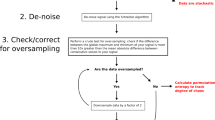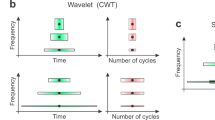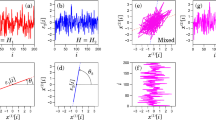Abstract
There is evidence that physiological signals under healthy conditions may have a fractal temporal structure1. Here we investigate the possibility that time series generated by certain physiological control systems may be members of a special class of complex processes, termed multifractal, which require a large number of exponents to characterize their scaling properties2,3,4,5,6. We report onevidence for multifractality in a biological dynamical system, the healthy human heartbeat, and show that the multifractal character and nonlinear properties of the healthy heart rate are encoded in the Fourier phases. We uncover a loss of multifractality for a life-threatening condition, congestive heart failure.
This is a preview of subscription content, access via your institution
Access options
Subscribe to this journal
Receive 51 print issues and online access
$199.00 per year
only $3.90 per issue
Buy this article
- Purchase on Springer Link
- Instant access to full article PDF
Prices may be subject to local taxes which are calculated during checkout





Similar content being viewed by others
References
Bassingthwaighte, J. B., Liebovitch, L. S. & West, B. J. Fractal Physiology(Oxford Univ. Press, New York, (1994).
Dewey, T. G. Fractals in Molecular Biophysics(Oxford Univ. Press, Oxford, (1997).
Stanley, H. E. & Meakin, P. Multifractal phenomena in physics and chemistry. Nature 335, 405–409 (1988).
Vicsek, T. Fractal Growth Phenomena, 2nd edn (World Scientific, Singapore, (1993).
Takayasu, H. Fractals in the Physical Sciences(Manchester Univ. Press, Manchester, UK, (1997).
Stanley, H. E. in Fractals and Disordered Systems2nd edn (eds Bunde, A. & Havlin, S.) 1–68 (Springer, Berlin, (1996).
Shlesinger, M. F. Fractal time and 1/f noise in complex systems. Ann. NY Acad. Sci. 504, 214–228 (1987).
Malik, M. & Camm, A. J. (eds) Heart Rate Variability(Futura, Armonk, NY, (1995).
Akselrod, S.et al. Power spectrum analysis of heart rate fluctuations: a quantitative probe of beat-to-beat cardiovascular control. Science 213, 220–222 (1981).
Kobayashi, M. & Musha, T. 1/f fluctuation of heartbeat period. IEEE Trans. Biomed. Eng. 29, 456–457 (1982).
Hausdorff, J. M.et al. Fractal dynamics of human gait: stability of long-range correlations in stride interval fluctuations. J. Appl. Physiol. 80, 1448–1457 (1996).
Peng, C.-K., Havlin, S., Stanley, H. E. & Goldberger, A. L. Quantification of scaling exponents and crossover phenomena in nonstationary time series. Chaos 5, 82–87 (1995).
Hurst, H. E. Long-term storage capacity of reservoirs. Trans. Am. Soc. Civ. Eng. 116, 770–808 (1951).
Vicsek, T. & Barabási, A. L. Multi-affine model for the velocity distribution in fully turbulent flows. J.Phys. A 24, L845–L851 (1991).
Barabasi, A.-L. & Stanley, H. E. Fractal Concepts in Surface GrowthCh. 24 (Cambridge Univ. Press, Cambridge, (1995).
Daubechies, I. Ten Lectures on Wavelets(SIAM, Philadelphia, (1992).
Ivanov, P. Ch.et al. Scaling behaviour of heartbeat intervals obtained by wavelet-based time-series analysis. Nature 383, 323–327 (1996).
Muzy, J. F., Bacry, E. & Arneodo, A. Wavelets and multifractal formalism for singular signals: application to turbulence data. Phys. Rev. Lett. 67, 3515–3518 (1991).
Muzy, J. F., Bacry, E. & Arneodo, A. The multifractal formalism revisited with wavelets. Int. J. Bifurc. Chaos 4, 245–302 (1994).
Peng, C.-K.et al. Fractal mechanisms and heart rate dynamics: Long-range correlations and their breakdown with disease. J. Electrocardiol. 28, 59–65 (1996).
Thurner, S., Feurstein, M. C. & Teich, M. C. Multiresolution wavelet analysis of heartbeat intervals discriminates healthy patients from those with cardiac pathology. Phys. Rev. Lett. 80, 1544–2391 (1998).
Amaral, L. A. N., Goldberger, A. L., Ivanov, P. Ch. & Stanley, H. E. Scale-independent measures and pathologic cardiac dynamics. Phys. Rev. Lett. 81, 2388–2391 (1998).
Lefebvre, J.et al. Predictability of normal heart rhythms and deterministic chaos. Chaos 3, 267–276 (1993).
Yamamoto, Y.et al. Operation Everest II: an indication of deterministic chaos in human heart rate variability at simulated extreme altitude. Biol. Cybern. 69, 205–212 (1993).
Kanters, J. K., Holstein-Rathlou, N. H. & Agner, E. Lack of evidence for low-dimensional chaos in heart rate variability. J. Cardiovasc. Electrophysiol. 5, 128–137 (1994).
Sugihara, G., Allan, W., Sobel, D. & Allan, K. D. Nonlinear control of heart rate variability in human infants. Proc. Natl Acad. Sci. USA 93, 2608–2613 (1996).
Poon, C-S. & Merrill, C. K. Decrease of cardiac chaos in congestive heart failure. Nature 389, 492–495 (1997).
Meneveau, C. & Sreenivasan, K. R. Simple multifractal cascade model for fully developed turbulence. Phys. Rev. Lett. 59, 1424–1427 (1987).
Ivanov, P. Ch., Amaral, A. L. N., Goldberger, A. L. & Stanley, H. E. Stochastic feedback and the regulation of biological rhythms. Europhys. Lett. 43, 363–368 (1998).
Moody, G. B. & Mark, R. G. Development and evaluation of a 2-lead ECG analysis program. Computers Cardiol. 9, 39–44 (1983).
Acknowledgements
We thank A. Bunde, U. Frisch, J. M. Hausdorff, V. Horváth, H. Kallabis, R.G. Mark, J. Mietus, C.-K. Peng, K. R. Sreenivasan and B. J. West for discussions. We are especially grateful to A. Arneodo and T. Vicsek for advice on the analytical technique and on the text and R. Goldsmith for providing the blind test data. This work was supported by NASA, NIH, FCT/Portugal, and The G. Harold and Leila Y. Mathers Charitable Foundation.
Author information
Authors and Affiliations
Corresponding author
Rights and permissions
About this article
Cite this article
Ivanov, P., Amaral, L., Goldberger, A. et al. Multifractality in human heartbeat dynamics. Nature 399, 461–465 (1999). https://doi.org/10.1038/20924
Received:
Accepted:
Issue Date:
DOI: https://doi.org/10.1038/20924
This article is cited by
-
Classification of drought severity in contiguous USA during the past 21 years using fractal geometry
EURASIP Journal on Advances in Signal Processing (2024)
-
Sex differences in prenatal development of neural complexity in the human brain
Nature Mental Health (2024)
-
Nonlinear analysis of heart rate variability signals in meditative state: a review and perspective
BioMedical Engineering OnLine (2023)
-
Personalized relapse prediction in patients with major depressive disorder using digital biomarkers
Scientific Reports (2023)
-
Simplicial complex entropy for time series analysis
Scientific Reports (2023)
Comments
By submitting a comment you agree to abide by our Terms and Community Guidelines. If you find something abusive or that does not comply with our terms or guidelines please flag it as inappropriate.



